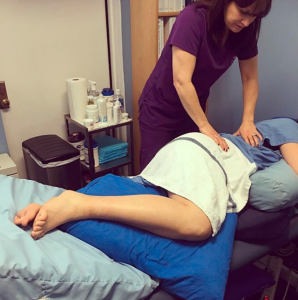
Here we are treating a pregnant patient who is preparing for labor and delivery. Because the pelvic floor muscles traverse the body it is considered to function as a diaphragm by many. When we tested the mobility of her diaphragms they were out of sync. The respiratory and pelvic diaphragms should move in coordination together. This could impact breathing and efficiency of delivery. This technique helps to release any tension and asymmetries and correct excursion in the diaphragms. The patient only feels mild pressure over the rib cage and pelvic bone (ilia). This is a strain-counterstrain technique with positional release. The techniques are followed up with neuromuscular re-education techniques so normal breathing and coordination of the diaphragms are restored. This facilitates more ease of delivery when the pelvic floor is maximally relaxed. We also use these techniques on many of our postpartum and pelvic pain patients. The pelvic (floor) diaphragm is maximally stretched upon labor and delivery. Pain can limit breathing which can alter diaphragmatic excursion. When the diaphragms move in normal concert it facilitates efficient digestion and respiration and blood flow into the pelvic bowl (pelvic girdle). Balancing the diaphragms can help a patient regain pelvic floor strength postpartum. Thus, getting the diaphragms balanced optimizes abdominopelvic well-being. So whether you are pregnant, postpartum, or have pelvic pain come see us for expert care.



